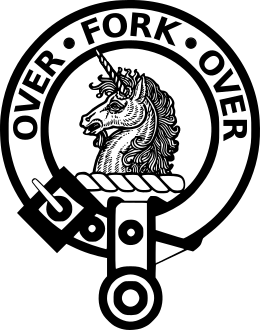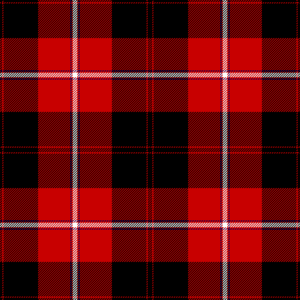Clan Cunningham facts for kids
Quick facts for kids Cunningham |
|||
|---|---|---|---|

Crest: A silver unicorn's head with mane and horn of gold
|
|||
| Motto | "Over Fork Over" | ||
| War cry | None | ||
| Profile | |||
| Region | Scottish Lowlands | ||
| District | Ayrshire and Renfrewshire | ||
| Animal | unicorn | ||
| Chief | |||
 |
|||
| Sir John Christopher Foggo Montgomery Cunninghame of Kilmaurs or Callum Cunningham | |||
| Baronet of Corsehill Chief of the name and arms of Cunninghame |
|||
| Historic seat | Finlaystone Castle | ||
|
|||
|
|||
|
|||
Clan Cunningham is a historic Scottish clan. Its roots go back to the 12th century. The first official records of the clan chiefs appeared in the 13th century. The Cunninghams were strong supporters of Robert the Bruce. He fought for Scottish independence. In the 15th and 16th centuries, the Clan Cunningham had a long-running rivalry with the Clan Montgomery. For a long time, the chief of Clan Cunningham was known as the Earl of Glencairn. Today, the chief is the Cunningham of Corsehill. Sir John Christopher Foggo Montgomery Cunninghame became the recognized chief in 2013. This happened after the chiefship had been empty for over 200 years.
Contents
History of Clan Cunningham
How the Clan Started
The Cunningham family comes from a region called Cunninghame. This area is in the northern part of Ayrshire. One story says that King Malcolm gave land to a man named Malcolm, son of Freskin, in 1059.
The first known ancestor of the Cunningham family was Warnebald. He received land in Manor Cunningham between 1135 and 1140. Another story tells how the son of Friskin helped Malcolm III of Scotland. He hid the king under hay in a barn. This event is said to be the reason for the family's coat of arms. It shows a "shake-fork." Their motto, Over fork over, also comes from this story. Some say the coat of arms shows their role as masters of the King's Stables.
By the late 1200s, the Cunninghams were well-known in Kilmaurs. Hervy de Cunningham, son of the Laird of Kilmaurs, fought in the Battle of Largs in 1263. This battle was against Norse invaders. The king later gave him a special paper. It confirmed his ownership of all his lands.
Fighting for Scottish Freedom
During the Wars of Scottish Independence, the Cunninghams supported the Bruces. They fought for Scotland's freedom. However, in 1296, their name appeared on the Ragman Rolls. This meant they had sworn loyalty to Edward I of England. After Robert the Bruce won, he was generous to his supporters. In 1319, the lands of Lamburgton were added to Kilmaurs. This was a gift from the king.
Sir William Cunningham of Kilmaurs was an important figure. In 1354, he was offered as a hostage to the English. This was to help free David II of Scotland from captivity. Sir William's oldest son, also named William, married Margaret Denniston. Through her, he gained a lot of land. This included Glen Cairn and Finlayston in Renfrewshire.
Clan Rivalries and Conflicts
Sir William Cunningham's grandson became Lord Kilmaurs in 1462. Later, he was made Earl of Glencairn. One of his younger brothers started the Caprington branch of the clan. This branch also became very important. Other notable branches include the Cunninghams of Cunninghamhead, Aitket, Robertland, and Corsehill.
In 1488, the Clan Montgomery attacked and burned Kerelaw Castle. This castle belonged to the Cunninghams. This was part of a long-standing rivalry between the two clans. The feud began when the Cunninghams lost control of an important local office. This office, called Baillie of Cuninghame, was given to a Montgomery in 1448. The clans had also been on opposite sides in the Battle of Sauchieburn. In that battle, the Cunningham chief was killed.
The rivalry continued into the 16th century. In 1528, the Cunninghams burned down Eglinton Castle. This castle belonged to the Montgomerys. In 1586, a Montgomery chief, Hugh Montgomery, was traveling. He stopped at Lainshaw Castle to dine. A signal was given, and Cunninghams attacked him. He was killed near Annick Ford. This led to more revenge attacks. Many Cunninghams were killed in return. The government of King James VI of Scotland eventually stepped in. They made the chiefs of both clans agree to peace. In 1661, the Earl of Glencairn married a Montgomery. This helped to finally end the long feud.
In 1513, Cuthbert Cunningham, Earl of Glencairn, died at the Battle of Flodden. The fifth Cunningham Earl of Glencairn was a Protestant leader. He supported John Knox. Glencairn fought against Mary, Queen of Scots. He was one of the commanders at the Battle of Carberry Hill in 1567. Mary surrendered there. The Cunninghams were also involved in the Plantation of Ulster. Sir James Cunningham received land in County Donegal. The Cunningham name is still very common in Ulster today.
The 17th Century and Civil War
During the Scottish Civil War, William Cunningham, 9th Earl of Glencairn, supported Charles II of England. In 1653, Glencairn gathered a force. He wanted to fight against General Monk. In 1654, Glencairn took control of Elgin. He tried to rally all of Scotland against Oliver Cromwell. However, his uprising did not succeed. Glencairn survived, and after the king returned to power, he became Lord Chancellor of Scotland.
In 1669, Sir John Cunningham of Caprington became a Baronet of Nova Scotia. This was a special title given by King Charles II.
The 18th Century and Famous Cunninghams
At the Battle of Culloden in 1746, a British artillery company was called Captain Cunningham's Company. They fired grapeshot at the Jacobites.
Many Cunninghams became famous. Alexander Cunningham was a writer of history. He was also a British envoy to Venice from 1715 to 1720. Charles Cunningham was known for his historical paintings. Some of his works are in the Hermitage Palace in Saint Petersburg. Others are in Berlin. William Cunningham of Robertland was a friend of the famous poet Robert Burns. Allan Cunningham was also a poet and writer. Some people thought he was almost as good as Burns. His work was supported by Sir Walter Scott. Scott even helped Cunningham's children after his death.
Clan Cunningham Castles
The Clan Cunningham has many historic castles and estates:
- Finlaystone Castle: Located near Port Glasgow. The Cunninghams held it from 1399 to 1873. It was the home of their chiefs, the Lords Kilmaurs and later the Earls of Glencairn.
- Kilmaurs Place: This house is near Kilmarnock in County Ayershire. It dates from 1620. The Cunninghams have owned the Kilmaurs lands since the 13th century.
- Kilmaurs Castle: The Cunninghams had an older stronghold near Jocksthorn Farm in Kilmaurs.
- Glencairn Castle: Now called Maxwelton House. It is near Moniaive in Dumfries and Galloway. It was a 17th-century tower house. The Cunninghams of Kilmaurs gained it in the 15th century. It was named Glencairn after their earldom.
- Caprington Castle: Located near Kilmarnock, Ayrshire. It has a large 15th-century tower. The Cunninghams gained it in 1425 through marriage. They were then known as 'of Caprington'.
- Aiket Castle: About four miles south-east of Beith, Ayrshire. It is a 16th-century tower house. The Cunninghams of Aiket held these lands for a long time.
- Robertland Castle: About one-mile north-east of Stewarton, Ayrshire. The Cunninghams held it in 1506.
- Kerelaw Castle: Built by the Cunningham Earls of Glencairn. It was destroyed in a clan feud in 1488. The Clan Montgomery attacked it again in 1528.
- Kyle Castle: In East Ayrshire, it was once owned by the Cunningham Clan.
- Auchenharvie Castle.
- Corsehill Castle, Stewarton.
- Lainshaw Castle, Stewarton.
- Clonbeith Castle, Auchentiber.
- Montgreenan Castle, Auchentiber.
- Glengarnock Castle.
- Lambroughton.
- Lands of Doura.
- Thorntoun house and estate: Near Kilmarnock. The Cunninghams held it from 1699.
- Towerlands: A small estate once held by the Cunningham Clan.
See also
- Barony and Castle of Corsehill
- Cunningham
- Cunninghamhead
- Cunninghamhead Estate
- Cunninghamhead, Perceton and Annick Lodge



